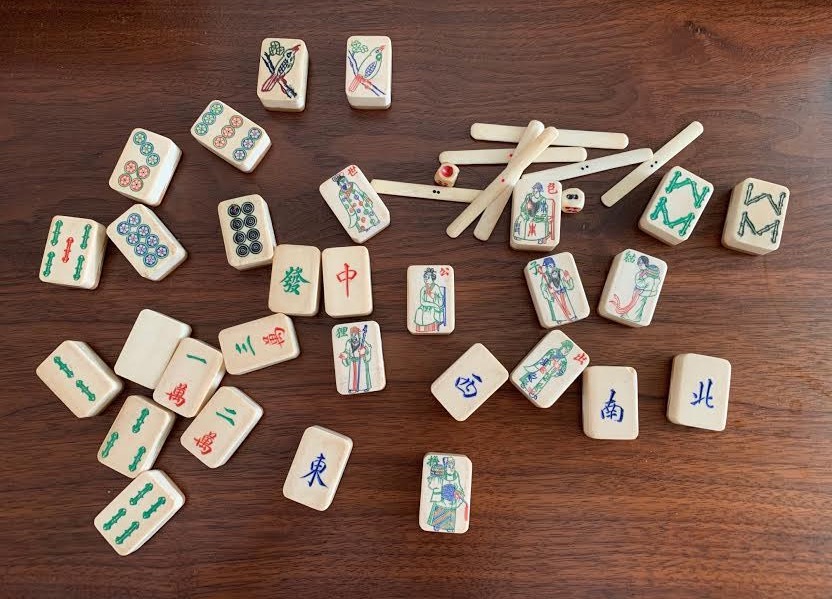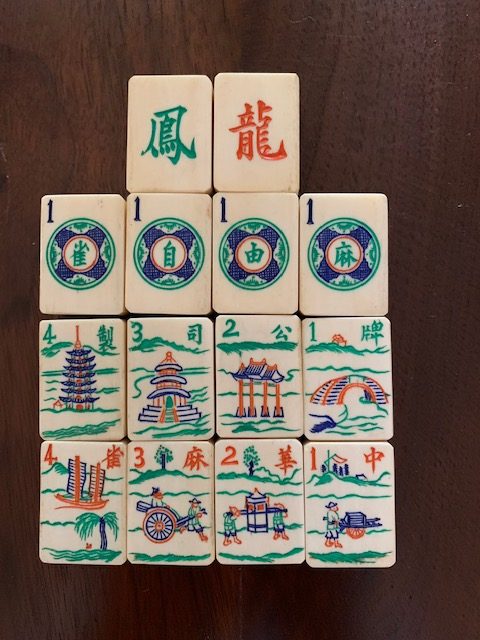
No one really knows when the game began, but most think it started in China during the 1300s as a card game, similar to rummy, played by four people sitting around a table. People in China loved card games, but this one was a great favorite. The game probably was somewhat similar to what the goals are today: putting groups of numbers and suits together, in certain patterns, and to be the first to complete a hand. People wanted to play it all the time. Of course there were some problems with paper cards which would get torn, and bent with so many hours of play. Madiao was an early form of the game. British mahjong historian Michael Stanwick has a very detailed website with historical references and photographs of a variety of old sets. You can find his work at https://www.themahjongtileset.co.uk. There you’ll find an incredible treasure trove of information. Tom Sloper also has a complete write-up on the history of the game: https://www.sloperama.com/mjfaq/mjfaq11.htm
Throughout the years, until the mid 1800s, the images and suits changed to become similar to the images we see today: three suits, Winds, Dragons (which were not originally Dragons but became that when the game was actively exported to the States and Europe), and Flowers. The Chinese had special combinations of tiles named hands, calling up uniquely Chinese legends and traditions.
Joseph P. Babcock, an American working in China in 1917, came up with the idea of exporting the game to the United States and Europe. He and others formed the Mah-Jongg Sales Company of America (MJSA) Sadly he thought the way the Chinese played would be much too complicated for Americans and Europeans (!), so he changed the rules and scoring. He created a rule-book, Babcock’s Rules for Mah-Jongg.

Initially he had his staff buy up existing sets from workshops, after requiring the craftsmen add our numbers and letters to the tiles. Chinese sets didn’t have our numbers or letters because the Chinese could read their own characters (words and numbers), but for foreigners to play, “translations” were necessary..
Eventually, they designed their own tiles, known for the unique One Dots with Chinese characters inside, Flowers with Chinese scenes of transportation and architecture, and Green and Red Dragons with the characters for Phoenix (representing the Chinese Empress) and Dragon, representing the Emperor.

Mah-Jongg became a hit. Soon others realized that Babcock essentially was marketing a set of tiles, similar to a deck of cards with slightly altered designs from original Chinese sets, and a rule book. Lots of other companies followed suit (couldn’t help myself there) with their own tiles and rules, and of course names and spellings for their version, since Mah-Jongg was trademarked and copyrighted. (That’s why, if you are ever asked how to spell mahjong in a spelling bee, you can never be wrong-that spelling is probably out there!)
Needless to say, with all these versions out there nobody could agree on the right way to play, and the game dropped out of favor, but not everywhere. Different communities in the United States kept the game as part of their preferred pastimes, but the issues of how everyone should play the game still was an issue. So in 1937 five Jewish women came together and formed the National Mah Jongg League, introducing their own way of play (borrowing here and there) and history was made. They focused on Mah Jongg, their preferred spelling, as a pastime that brought people together, thus forming friendships. The fee required to buy a card to play each year assuaged guilt for players since some of the money went to support charities. (Even today a percentage of money collected by charitable groups from their members to buy the yearly card is paid back to the organization that raised the money.) “The League” version of play never went out of favor. Throughout the years the League changed the numbers of Flowers (at first Flowers were wild tiles), eventually adding Jokers as true wild tiles and letting Flowers become their own special category. (An editing error indicated the number of tiles needed for the game was settled in the late 60s. Actually although the number of Jokers was finalized then, the eight Jokers and Flowers were set in 1971. ) You might want to read Linda Fisher’s write-up: http://mahjblog.blogspot.com/2012/01/jokers-take-them-or-leave-them.html.
Although at first the NMJL members were mostly Jewish older women, now teenagers, young and middle-aged people, and even men enjoy the pastime. The game is seen as a wonderful way to socialize while exercising the brain, all the while escaping from worries of daily life.
Another American version grew organically in the Mid-west. During the 1920s when Wright-Patterson Air Force Base was still McCook Field, officers’ spouses started to create their own game. The wives at the airfield and then Air Force base created their own version of the game, so that service families could transfer “from Base to Post to Port and still play the same game.” They made changes to rules, scoring, and even came up with some uniquely American names for hands. The rules were only copy-righted in 1963. An interesting side-note. Wright Patterson is run by volunteers. All profits go to welfare and charitable organizations.
Unlike the National Mah Mongg League the hands do not change on a yearly basis, and booklets of hands last several years. There are the names of some of the hands, many perfect for military families: Pearl Harbor, Independence, Moon Landing, and Civil War using the North and South Tiles.
England has a few versions of the game, with one involving a tile exchange (what we call the Charleston) called Goulash. And if there’s a wall game (no One wins) four Jokers are incorporated into the tile set and the four 2 Bams are removed-if there are no Jokers the 2 Bams become wild tiles (they’re no longer 2 Bams). Australia has its own variation, with special Aussie hands. In Singapore, getting related Flower tiles (Capture tiles) gives the player more points. Riichi is the Japanese approach to the game, without Flower tiles and with other unique rituals. Interestingly an old Chinese version was deemed illegal by the Communist Government because it promoted gambling. It was replaced by Mahjong Competition Rules (MCR), and the way the game is scored was changed so as to discourage gambling. MCR and Riichi are two of the most played versions of the game.
The game is constantly changing, and players and controlling boards come up with new ideas, hands and approaches. These small pieces of art, with endless ways of combining them, are loved by people all over the world.